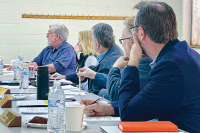Many buildings certifiably green; others just follow the LEED
What do Harrill Residence Hall at Western Carolina University, the Cherokee Central School System, the new Oconaluftee Visitor Center in the Smokies and the firehouse in Sylva have in common?
Each of these projects help make a whole: they are part of a burgeoning green-building trend in Western North Carolina that, in recent years, has seen sustainable commercial construction become less of a niche and more of the norm.
“It is definitely becoming mainstream,” said Lauren Bishop, campus energy manager for WCU, where a green retrofitting of Harrill dorm is under way and the earth friendly Health and Human Sciences Building was recently completed.
These green buildings use less power and water, are often built in a pre-existing footprint, produce less waste and use recycled materials. Most incorporate more natural light and fresh air than standard commercial buildings.
Some are certified sustainable, others are not: LEED (Leadership in Energy and Environmental Design) certification is the recognized standard (see sidebar on LEED certification). But that stamp of approval comes at a recurring annual cost and a whole lot of paperwork.
SEE ALSO: The price of being certifiably ‘green’
Related Items
As George Stanley, projects manager for Southwestern Community College, put it when describing the non-certified but sustainable Conrad G. Burrell administration/bookstore building under way there, one can have a perfectly fantastic pedigree dog without having in hand the actual pedigree papers.
With or without the certification, WNC architects and local governments are paying increasing attention to sustainable building practices.
Not just green: healthy
Scott Donald is a principal architect with Padgett and Freeman Architects. The Asheville company drafted the plans for the massive new campus that’s home to Cherokee Central Schools, as well as the tribal emergency operations center. Both are LEED certified, but Donald said that he would try to bring environmental sustainability to the projects even without the certification, just because it’s his professional habit.
“This office has been doing that since the early 70s,” Donald said. “It’s really just environmentally conscious architecture.”
The schools in particular are chockablock with sustainable measures. It’s a sprawling, 473,000-square-foot campus that houses kindergarten through high school and incorporates green technology at every turn. There are waterless urinals, daylight sensors in every room to maximize natural light and minimize the artificial light used, underground cisterns stowed beneath the schools’ courtyards that can hold 60,000 gallons of rainwater for irrigation and toilet flushing. And, the school is heated by 450-foot geothermal wells that were drilled beneath the school to make use of the earth’s warmth.
The project cost $140 million, but Yona Wade, director of the school’s cultural arts center, said the benefits are worth the extra money spent to LEED certify the buildings. The measures will save the school system money in the long term — $10 million over 40 years, according to Donald.
In Cherokee, the impetus for green building is largely rooted in a 2009 environmental proclamation made by Principal Chief Michell Hicks. He directed the tribe toward greater care for the environment in its policies.
“It comes from wanting to be good stewards of what we have,” Wade said. “This has got to be the building that will last us. We’ll probably never do this again.”
The sun and the wind are free
O’Dell Thompson, a Sylva architect, has chosen not to take the classes and pay the fees necessary to get LEED certified. But he designs in an environmentally friendly manner “because that’s the right thing to do.”
“I do a lot of houses, churches and stuff,” Thompson said. “With all of my clients, I encourage them to take advantage of the things that are free — the sun and the wind.”
Thompson was the architect on Sylva’s new firehouse.
He remembers that when Sylva leaders were developing the concept for the new firehouse, then Mayor Brenda Oliver emphasized, “no matter what, it should be as environmentally sensitive as possible,” Thompson said. “So that was one of our goals from the outset.”
Last fall, the firehouse was completed. Not too many years ago the obviously sustainable building might have seemed incongruous in this mountain town of just 2,500, with its large solar panels displayed prominently on the roof. But these days? It really hasn’t occasioned much comment.
There is a solar pre-heating hot water system that heats water to circulate under the slabs where the fire trucks rest when not in use. This saves propane costs — you can’t let a fire truck, full of potentially lifesaving water, freeze during the winter. The slab retains heat because it has thermal mass, which helps keep temperatures warmer.
Up to eight solar tubes help with lighting the firehouse. So much so, Thompson said a butterfly baffle had to be installed near the television so that the firemen could see the screen. The building is south facing, and there’s an overhang to prevent heat buildup in summer and accept heat during the winter.
There are photovoltaics, which is a method of generating power by converting solar radiation into direct current electricity. There are no batteries being charged, the electricity generated simply offsets any electric costs.
The firehouse is metal, meaning parts of it were probably recycled; the men’s room has a waterless urinal to save on water use.
The building avoids the use of volatile organic compounds in the paints or carpet.
“It’s not just green,” Thompson said. “It’s an environmentally healthy structure.”
Green building helps bottom line
Tim Chapman is the associate director for facilities in the office of residential living at WCU. He’s a practical kind of fellow, one who clearly understands and appreciates the virtue and necessity of the bottom line.
“We’re a business,” Chapman said. “Everything we do must be done in sound business terms.”
Each of the 13 buildings he helps oversee is an individual “cost center,” meaning they have to cost out each year, bringing in enough money to offset expenses. But these days, that doesn’t exclude incorporating green practices — in fact, sustainable building techniques can save you money, Chapman said.
“The desire has been there for years, but the manufacturing process and science (of green building) is catching up,” he said.
WCU has reused sites instead of eating up more green space as it has entered a new building phase in recent years. More green space, in fact, has been added on campus.
There also have been such innovations as a central chilling plant to cool the buildings on the campus quad instead of separate units, and on-demand hot water heaters.
And Harrill dorm, a 38-year-old residence hall being upgraded and improved, will be the ultimate sustainable “showpiece” on campus, Chapman said.
Work has started on the 400-bed dorm, which should be completed by next summer. The $15 million project will include extensive upgrades to outdated heating, ventilation, air conditioning, electrical and plumbing systems.
Plans call for the installation of a rooftop rainwater collection system to provide water for flushing toilets, solar panels to supplement water heating and geothermal wells for heating and cooling.
WCU Architect Galen May said the new dorm will also allow students to be highly energy conscious. An energy monitor will be added to each pair of floors that will allow students to monitor their energy consumption.
A dashboard will be in the lobby so that all residents can view energy consumption throughout the entire dorm.
“It’s our responsibility to set a good example, and to teach our students about this aspect,” Bishop, the campus energy manager, said.
May said Harrill would serve as a learning tool for students. And, perhaps, it will serve as one for the region, too.
By Quintin Ellison and Colby Dunn
LEED ‘green’ buildings in WNC
• Cherokee Emergency Operations Center, Cherokee
• Ravensford School Project, Cherokee Central Schools
• Registered (in process of LEED certification)
• One single-family home in Bryson City
• Oconaluftee Visitor’s Center – Cherokee
• Haywood Community College, Creative Arts Building – Clyde
• Two single family homes in Franklin
• Unitarian Universalist Fellowship – Franklin
• Best Buy – Waynesville
• One single-family home – Sylva
• Cherokee Operations Center – Whittier
• Harrill Hall renovations – WCU
• WCU Health and Gerontological Building – Cullowhee
Source: U.S. Green Building Council









